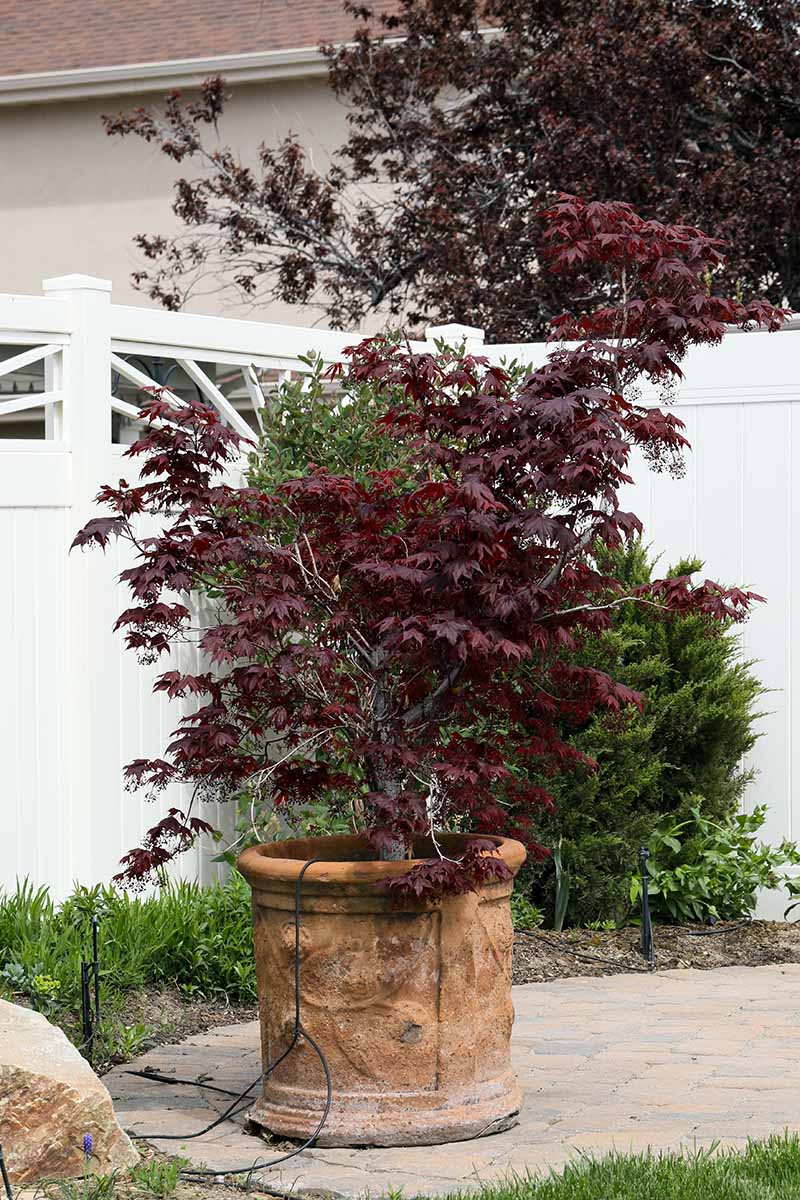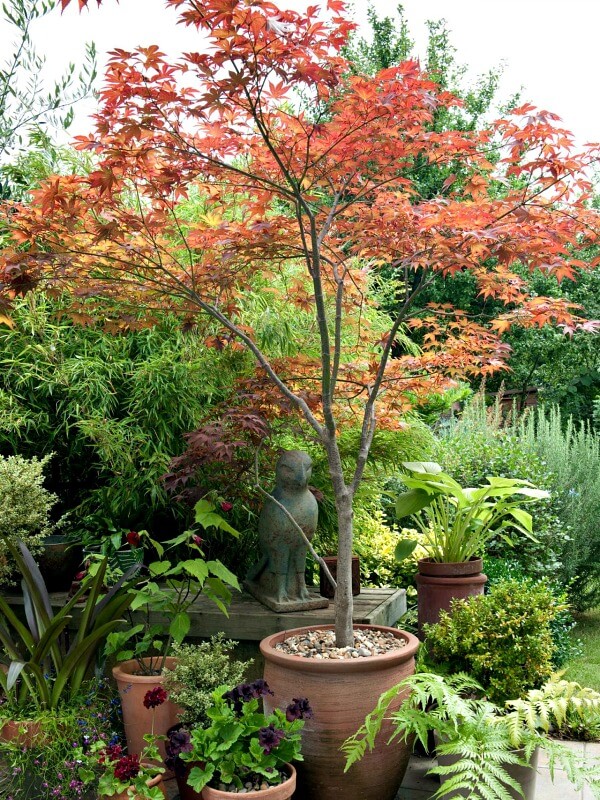/arc-anglerfish-arc2-prod-dmn.s3.amazonaws.com/public/ZK7S6QA7V3KARUZA3OTY7OVJT4.jpg)
Let those Japanese maples stay potted; they can take it
Learn about Japanese maple tree care and pruning, explore some of the many varieties of Japanese maples, and why these trees are great for container planting.. Perfect for pocket gardens and containers, it reaches 4 to 5 feet tall by 6 to 8 feet wide over 10 years in the landscape; about 4 feet by 5 feet in a container. Photo by: Rob.
Growing Japanese Maples in Pots PlantingTree
1. You can grow any Japanese Maple in a planter, but for the best results choose a cultivar that grows to 10 feet or less. 2. Choose a pot that drains well and is about 2 times the size of the rootball or the container your Japanese Maple is in now.

Pin by Caren Sawyer on Garden Container plants, Japanese garden, Plants
Japanese maples are a cornerstone plant in temperate gardens all over the world. There is an endless array of colors, textures, shapes, and sizes available on the market, making them incredibly versatile in the garden. Nothing adds an elegant ambiance to a landscape quite like a Japanese maple.

Growing Japanese Maples In Containers · Cozy Little House
Learn How to Grow a Japanese Maple Tree in a Pot and include this beautiful specimen in your house even if you have limited space!. If you have a patio, porch, garden area, then that is all you need to start planting a Japanese maple.The elegant, slim maple tree can thrive well in containers as long as you know how to take care of it.

Japanese maple in a pot for sanctuary patio Japanese garden plants, Japanese garden, Dwarf
Growing Japanese maple in pots is a great way to overcome having the wrong soil type, or an unfavorable climate for these graceful trees. There are lots of small and dwarf Japanese maples that are suitable for growing in containers. Once potted up they are generally low maintenance and easy to keep looking good year after year.

japanese maples in containers.I have the red kind in a big pot and seems to be doing just fine
Do Japanese Maples Do Well In Pots: Japanese maples are excellent ornamental trees to grow in pots. Their small size, relatively slow growth rate, and their non-invasive root systems makes them perfect for containers. You can grow any Japanese maple in a container, but for the best results choose a cultivar that grows to 10 feet or less.

How to Grow and Care for Japanese Maple Trees
Easy to grow, Japanese Maples are cold-hardy, remarkably adaptable to soil and climatic conditions, require little maintenance, and are worthy of featured positions such as lawn specimens or near patios where their spectacular leaf color changes throughout the year can be admired.

Japanese Maple Planter JapaneseGardenDesignStones Container gardening, Garden containers
Plant your tree at the same depth it was at in the nursery pot and keep the soil moist, but not soggy. Fertilize the potted plant weekly with half-strength liquid fertilizer from spring through mid-summer, and stop fertilizing after the end of July. Avoid keeping your potted Japanese Maple in a hot, sunny place or where it will get a lot of.

Japanese Maple Tree in a pot. Potted trees Pinterest Japanese maple, Potted trees and Gardens
Container-grown Japanese maples benefit from yearly fertilization to maintain healthy growth. Fertilize your potted Japanese maple once per year in early spring. Use a slow-release, granular fertilizer formulated for trees. Make sure the soil is moist and water well after fertilizing. Avoid fertilizing in summer or fall, as this can cause late.

Growing Japanese Maples In Containers · Cozy Little House
March 8, 2023 Fred Naumann Japanese Maple trees can make stunning long-term landscape features, but did you know they can also thrive and grow in pots? This lets you keep your tree on the small side and move it around as needed. Though container Japanese Maples require a bit more work in some ways, they also offer a lot more flexibility.

Acer palmatum 'Atropurpureum' Japanese Maple Deciduous Garden Plant In Pot eBay
11 Japanese Maples For Containers Written by Igor Viznyy, horticulturist and plant expert. Last updated: March 24, 2023 Growing potted trees is a very fascinating activity. In this article, you will find the varieties of Japanese Maples that are best suited for pots. Geisha Gone Wild Japanese Maple Acer palmatum 'Geisha Gone Wild'

Potted Japanese Maple Potted trees, Container gardening, Container garden design
Bihou Japanese Maple, Acer palmatum 'Bihou'. 'Bihou' is an exciting new small variety with green foliage that turns vivid gold, orange, and red before dropping in the fall. The bare stems that follow turn brilliant yellow-gold with orange highlights. 'Bihou' prefers protection from hot afternoon sun.

Update! I planted this Bloodgood Japanese Maple in a container along with 3 Wheee
Place the Japanese Maple pot in a location with 4-6 hours of direct sunlight per day. Water when the soil in the pot is 2 inches dry. Fertilize the tree once a year with a slow-release fertilizer in early spring. Mulch the soil surface with compost or other organic material 1-2 inches thick. Prune the potted Japanese Maple lightly just to give.

Growing Japanese Maples In Containers · Cozy Little House
The best pot for Japanese maples should provide adequate space for the tree's shallow root system, have good drainage, and be sturdy enough to support the tree. These are the top things we look for when selecting a pot for Japanese maples: Size: Opt for a pot that is at least 2-3 times larger than the tree's root ball. Japanese maples have.
Growing Japanese Maples in Pots —
last updated May 03, 2021 Can Japanese maples be grown in containers? Yes, they can. If you have a porch, a patio, or even a fire escape, you have what you need to start growing Japanese maples in containers. These graceful, slender maple trees ( Acer palmatum) thrive in pots as long as you know how to plant them.

46 Japanese Maple Tree Landscaping Ideas Garden Design
Japanese maples are one of the most common species of tree grown as bonsai. So, you're in for a resounding yes - it's possible, you can grow Japanese maples in pots! While the dwarf or semi-dwarf cultivars are the easiest, you can grow any variety in a container because they all have a compact root system that tolerates confinement.